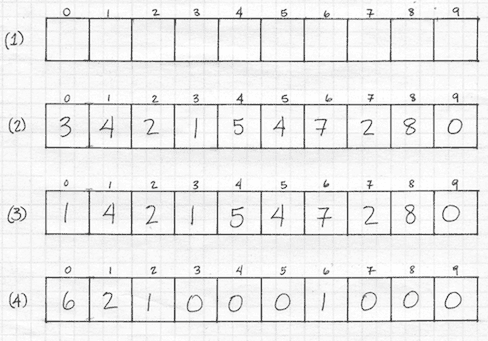In the ten cells shown here, you are to enter a ten-digit number such that the digit in the first cell tells how many zeros are in the entire ten-digit number, the digit in the cell marked "1" tells how many ones are in the number, and so on. Thus, if the "4" cell has a 2 in it, then there are two 4's somewhere in the ten-digit number.

Solution

Discussion: This problem is about a number that, in a sense, talks about itself. It may take a few minutes to get the problem booted up into your head. That's part of the point, to have to take some time to see exactly what this number is supposed to look like.
Solving the Problem: One might be tempted to start building the number from scratch, beginning with, say, a 1 in the 0-cell. This puts a 1 in the 1-cell too, but uh-oh, now you have two 1's, not just one. OK, put a 1 in the 2-cell and a 2 in the 1-cell. Then put the 0 in the 3-cell.
This is perfect: you have the four-digit number 1210, with one 0, two 1's, one 2, and one 0. Swell. But you have six more cells to fill. Well, if you keep working your way along, probably with lots of erasing, you'll eventually come to the ten-digit number 6210010000, which, by the way, is the only solution that anyone has ever found.
Another way to start is simply to fling any old numbers into the ten cells, and then start fixing the contradictions. You'll quickly notice that you can't have, say, a seven in the 5-cell and an eight in the 6-cell, because that means there are seven 5's and eight 6's in a ten-digit number. So we soon see that the numbers in the cells have to add up to ten--a nice thing to discover along the way.
So, given these two approaches, try them both out; see which one you like better.
Heuristics: #2, guess-and-try, is the most applicable here. It certainly is the quickest.
Using the Problem with Students:
As a class activity. When I've used this problem with students, it's usually been as a demonstration showing that simply making a guess (heuristic #2) can be a good way to start, and indeed that it's perfectly OK to guess. I make sure to take a few minutes for students to understand just how this mysterious ten-digit number is going to work. Then I draw the ten digit cells on the board (empty figure 2 on the pdf).
Then I tell the class, let's just make a wild guess and throw any old numbers in and see what it means (figure 2, for example). Call on some unlikely student to suggest numbers. Be reassuring, "Sure, they'll probably be wrong, but let's just see."
Here's what you'd say if you used the numbers in figure 2: "Well, let's see, this says that there are three 0's in the number, and that there are four 1's, and two 2's (hmm, that one's right, anyway), and so on. Maybe we can fix things up. Let's change the 0-cell to 1, since there is only one zero." (See figure 3.)
For whatever numbers you and the class threw in instead of what's in figure 2, you can start off the same way. This will trigger a rapid back-and-forth between you and the class, where suggestions come flying at you helter-skelter. It's impossible for me to predict how it will go – you're going to do a lot of erasing – but, amazingly, the final result will emerge, as in figure 4.
Along the way, maybe right off the bat, someone might observe that the sum of all the numbers in the cells has to be ten. I definitely wouldn't point this out – let somebody notice it, and then let the class absorb that news. This might lead to a radical revision of the trial numbers in the cells.
No matter what numbers you start with, the result in figure 4 will arrive. No other solution has ever been found, and yet I have no proof that this is the only one. If anybody gets anywhere with a proof, please let us know.
As an assigned problem. I make sure that the students understand what they're up against, and then leave them to it, either right in class, possibly paired up, or overnight. Somebody will get it very soon, and I make sure to keep the solution under wraps until everybody has had plenty of time to come up with it. Then we have a discussion of how the solution was found – maybe by making a guess and adjusting it, as above, or by some other method. You never know what some student will come up with – there's a saying, "The mind is a network of back roads."
In any case, make sure that the students see that guessing is an OK, indeed honorable, way to go.
Modifying or Extending the Problem: The problem could be modified, using the "what if not" technique. What if there aren't ten cells? A four-cell solution, 1210, appeared above. Is there another four-cell solution? How about a five-cell solution? And why is there only one known solution for the ten-cell problem? You are invited to send in anything you find that's interesting.
Remarks: I've never tried the "build it from scratch" approach with students. It might work just fine.